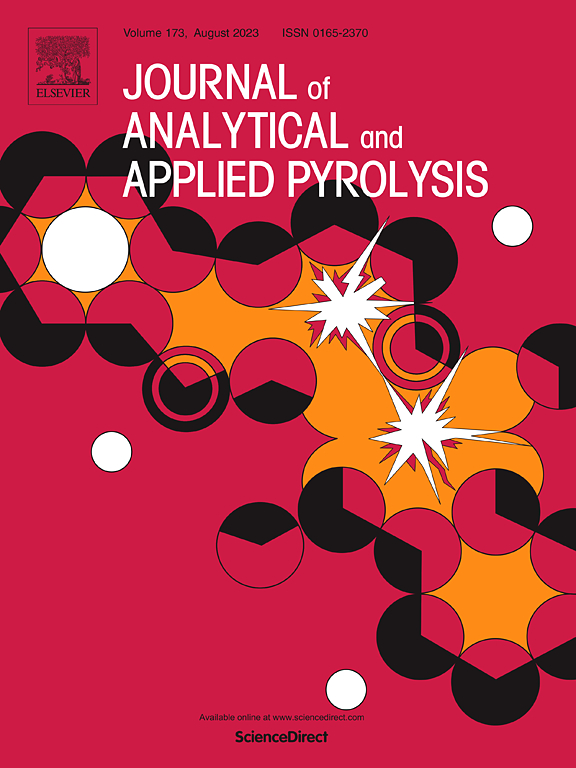Characterization of the sewage sludge derived biochar and evaluation of its effect on growth of Indian mustard [Brassica juncea (L.) Czern. & Coss.]
IF 5.8
2区 化学
Q1 CHEMISTRY, ANALYTICAL
引用次数: 0
Abstract
Sewage sludge management remains a pressing environmental concern due to heavy metals and pathogens that limit its direct agricultural application. This study investigates the production of biochar from sewage sludge through pyrolysis under varying thermal conditions (300°C, 500°C, and 700°C for 1–3 h) and evaluates its effectiveness as a soil amendment. Biochars were characterized for physicochemical properties, functional groups, morphology, crystallinity, and BCR heavy metal fractionation. Elevated pyrolysis temperature and extended residence time increased pH (6.2–9.8), water holding capacity (WHC: 26.5–55.6 %), and total ash content, while reducing volatile matter (VM: 30.1–6.0 %) and fixed carbon (FC: 18.1–3.7 %), indicating greater thermal stability. Further facilitated the formation of C–H and C![]() C bonds, along with deformation of C–O (carboxyl, ester) functional groups. Among nine treatment regimes, the 500°C treatment for 2 h (5T2H) was identified as optimal, with a yield of 65.4 %, pH 8.2, WHC 54.5 %, FC 14 %, and low VM (15.9 %). Ecological risk assessment showed a substantial global ecological risk (GER) reduction from 411 (high risk, raw sludge) to 245.9 (moderate risk, 5T2H). The 5T2H biochar was applied to soil at 5–50 % (w/w) and its effect on the growth and developemnt of Brassica juncea was evaluated. Significant improvements were observed in soil pH (7.1→7.7), WHC (22.9→38.4 %), and plant metrics, including germination (97 %), shoot length (6.4 cm), root length (6.6 cm), dry biomass (8.3 g), and chlorophyll content (8.5 mg/g FW). This study integrates pyrolysis optimization, metal speciation, and plant performance assessment, offering a comprehensive approach for transforming sewage sludge into an effective and low-risk soil amendment.
C bonds, along with deformation of C–O (carboxyl, ester) functional groups. Among nine treatment regimes, the 500°C treatment for 2 h (5T2H) was identified as optimal, with a yield of 65.4 %, pH 8.2, WHC 54.5 %, FC 14 %, and low VM (15.9 %). Ecological risk assessment showed a substantial global ecological risk (GER) reduction from 411 (high risk, raw sludge) to 245.9 (moderate risk, 5T2H). The 5T2H biochar was applied to soil at 5–50 % (w/w) and its effect on the growth and developemnt of Brassica juncea was evaluated. Significant improvements were observed in soil pH (7.1→7.7), WHC (22.9→38.4 %), and plant metrics, including germination (97 %), shoot length (6.4 cm), root length (6.6 cm), dry biomass (8.3 g), and chlorophyll content (8.5 mg/g FW). This study integrates pyrolysis optimization, metal speciation, and plant performance assessment, offering a comprehensive approach for transforming sewage sludge into an effective and low-risk soil amendment.
污泥生物炭的特性及其对芥菜生长的影响Czern。和输出电容。)
由于重金属和病原体限制了污泥的直接农业应用,污水污泥管理仍然是一个紧迫的环境问题。本研究研究了污水污泥在不同温度条件下(300°C、500°C和700°C, 1-3 h)热解生产生物炭,并评估了其作为土壤改进剂的有效性。对生物炭的理化性质、官能团、形态、结晶度和BCR重金属分馏进行了表征。升高的热解温度和延长的停留时间增加了pH值(6.2-9.8)、持水量(WHC: 26.5-55.6 %)和总灰分含量,同时降低了挥发分(VM: 30.1-6.0 %)和固定碳(FC: 18.1-3.7 %),表明热稳定性更好。进一步促进了C-H和CC键的形成,以及C-O(羧基、酯)官能团的变形。在9个处理方案中,500°C处理2 h (5T2H)被确定为最佳处理方案,产率为65.4 %,pH为8.2,WHC为54.5 %,FC为14 %,VM低(15.9 %)。生态风险评估显示,全球生态风险(GER)从411(高风险,原始污泥)大幅降低至245.9(中度风险,5T2H)。将5T2H生物炭以5 ~ 50% % (w/w)施用于土壤中,评价其对芥菜生长发育的影响。土壤pH值(7.1→7.7)、WHC(22.9→38.4 %)和植物指标(萌发率(97 %)、茎长(6.4 cm)、根长(6.6 cm)、干生物量(8.3 g)和叶绿素含量(8.5 mg/g FW)均有显著改善。本研究将热解优化、金属形态形成和植物性能评估相结合,为污泥转化为有效、低风险的土壤改良剂提供了综合途径。
本文章由计算机程序翻译,如有差异,请以英文原文为准。
求助全文
约1分钟内获得全文
求助全文
来源期刊
CiteScore
9.10
自引率
11.70%
发文量
340
审稿时长
44 days
期刊介绍:
The Journal of Analytical and Applied Pyrolysis (JAAP) is devoted to the publication of papers dealing with innovative applications of pyrolysis processes, the characterization of products related to pyrolysis reactions, and investigations of reaction mechanism. To be considered by JAAP, a manuscript should present significant progress in these topics. The novelty must be satisfactorily argued in the cover letter. A manuscript with a cover letter to the editor not addressing the novelty is likely to be rejected without review.

 求助内容:
求助内容: 应助结果提醒方式:
应助结果提醒方式:


